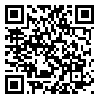

Volume 5, Issue 12 (Spring 2022)
J Altern Vet Med 2022, 5(12): 681-686 |
Back to browse issues page
Download citation:
BibTeX | RIS | EndNote | Medlars | ProCite | Reference Manager | RefWorks
Send citation to:



BibTeX | RIS | EndNote | Medlars | ProCite | Reference Manager | RefWorks
Send citation to:
Samadi A, Alizadeh S. Determination of the Diagnostic Role of Ultrasonography in Abdominal Injuries Caused by Mechanical Damage in Cats. J Altern Vet Med 2022; 5 (12) :681-686
URL: http://joavm.kazerun.iau.ir/article-1-96-en.html
URL: http://joavm.kazerun.iau.ir/article-1-96-en.html
1- Graduate of Veterinary Medicine, Faculty of veterinary medicine, Urmia Branch, Islamic Azad University, Urmia, Iran
2- Department of Clinical Sciences, Faculty of Veterinary Medicine, Urmia Branch, Islamic Azad University, Urmia, Iran ,s_alizadeh01@yahoo.com
2- Department of Clinical Sciences, Faculty of Veterinary Medicine, Urmia Branch, Islamic Azad University, Urmia, Iran ,
Abstract: (322 Views)
Background and aim: The aim of this study was to use ultrasonography to determine possible injuries in the abdominal cavity following mechanical trauma in order to identify cats with severe abdominal injuries that require urgent surgery.
Materials and Methods: This retrospective cross-sectional study was carried out on 22 affected cats with abdominal injuries caused by mechanical trauma. The results of clinical examinations, ultrasound and laparotomy (if performed) and the final diagnosis of the patient were recorded and the positive and negative results of ultrasound were matched with the results of laparotomy and the clinical course of the patient.
Results: In this study, the result of ultrasound in 14 cats (63.6%) was reported negative and without lesions and in 8 cats (36.4%) was positive. Among the mentioned cases, 6 cases (75%) had free-fluid abdominal lesion, 2 cases (25%) had pancreatic lesion, 1 case (12.5%) had kidney lesions, 1 case (12.5%) had intestinal lesions, and 2 cats (25%) had liver lesions. Therefore, the most common ultrasound report was free fluid accumulation in the abdomen. Of the 22 cases studied, 6 cases (27.3%) underwent laparotomy, and the result of laparotomy was positive in 5 cases (83.3%) and negative in 1 case (16.7%). In 2 cats (9.1%) the result of ultrasound was false negative and in one cat (4.54%) it was false positive. In this study, the sensitivity of ultrasound was 86.67% and its specificity was 85.71%.
Conclusion: In general, the results of this study show the important and valuable role of ultrasound as a primary diagnostic method to determine and diagnose free intra-abdominal fluid and intestinal and visceral injuries in ventricular trauma.
Materials and Methods: This retrospective cross-sectional study was carried out on 22 affected cats with abdominal injuries caused by mechanical trauma. The results of clinical examinations, ultrasound and laparotomy (if performed) and the final diagnosis of the patient were recorded and the positive and negative results of ultrasound were matched with the results of laparotomy and the clinical course of the patient.
Results: In this study, the result of ultrasound in 14 cats (63.6%) was reported negative and without lesions and in 8 cats (36.4%) was positive. Among the mentioned cases, 6 cases (75%) had free-fluid abdominal lesion, 2 cases (25%) had pancreatic lesion, 1 case (12.5%) had kidney lesions, 1 case (12.5%) had intestinal lesions, and 2 cats (25%) had liver lesions. Therefore, the most common ultrasound report was free fluid accumulation in the abdomen. Of the 22 cases studied, 6 cases (27.3%) underwent laparotomy, and the result of laparotomy was positive in 5 cases (83.3%) and negative in 1 case (16.7%). In 2 cats (9.1%) the result of ultrasound was false negative and in one cat (4.54%) it was false positive. In this study, the sensitivity of ultrasound was 86.67% and its specificity was 85.71%.
Conclusion: In general, the results of this study show the important and valuable role of ultrasound as a primary diagnostic method to determine and diagnose free intra-abdominal fluid and intestinal and visceral injuries in ventricular trauma.
Type of Study: Research |
Subject:
Radiology
Received: 2022/03/1 | Accepted: 2022/05/15 | Published: 2022/05/31
Received: 2022/03/1 | Accepted: 2022/05/15 | Published: 2022/05/31
Send email to the article author
| Rights and permissions | |
 |
This work is licensed under a Creative Commons Attribution-NonCommercial 4.0 International License. |




